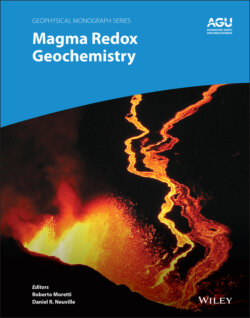Читать книгу Magma Redox Geochemistry - Группа авторов - Страница 28
2.3. MANTLE OXIDATION STATE OVER TIME AND ITS EFFECT ON THE C–O–H VOLATILE SPECIATION
ОглавлениеThe present‐day large oxygen fugacity range in Earth’s mantle (Fig. 2.1) reflects the evolution of the mantle through the pressure‐driven crystallization of the magma ocean to form Fe‐bearing minerals potentially able to set the fO2 locally (e.g., bridgmanite, ferropericlase, majorite, garnet; McCammon, 2005), trigger volatile outgassing and ingassing by recycling. Given that there is controversy regarding the dominant oxygen‐buffering species (e.g., Fe vs. C) even in the modern convecting mantle (e.g., Ballhaus & Frost, 1994; Cottrell & Kelley, 2013; Eguchi & Dasgupta, 2018), it is not surprising that to date it remains unclear how the redox state of the terrestrial mantle has evolved over time, and how this might have influenced volcanism, and ultimately, the atmospheric composition on Earth. Whether the chemical interaction between mantle rocks and volatile species like C played the most important role in determining conditions for the geological activity and habitability of our planet depends on the abundance of Fe (Fe0, Fe2+, and Fe3+) species compared to the abundance of C in its different forms (C0, CO, CO2, CH4) relevant in processes such as partial melting of rocks, melt migration, and diamond formation. However, three important variables influence the circulation of volatiles, among them carbon, in a planet: (i) the primordial volatile budget; (ii) the bulk oxygen fugacity of the early accreted terrestrial body; and (iii) the mineralogy of the planet’s interior. The deep volatile cycle in any planet is inextricably linked to changes of these variables through time.
